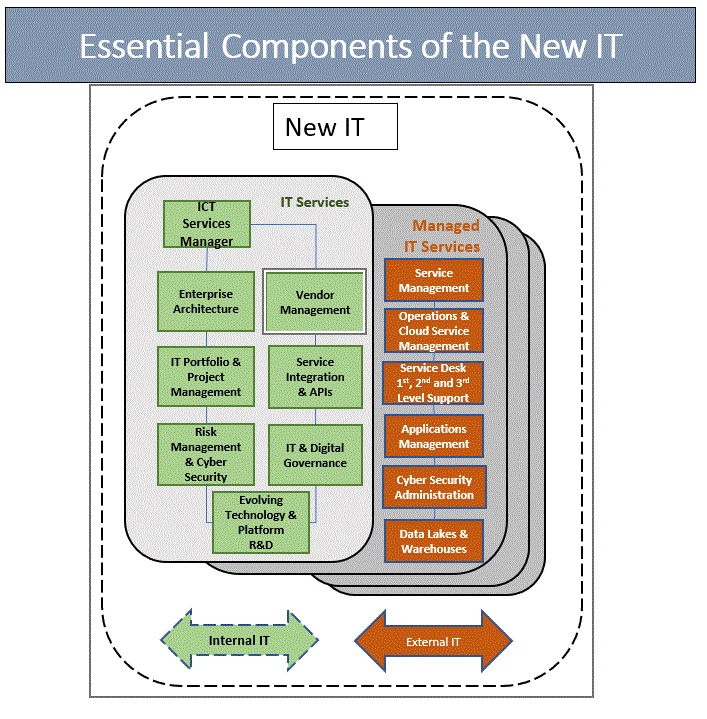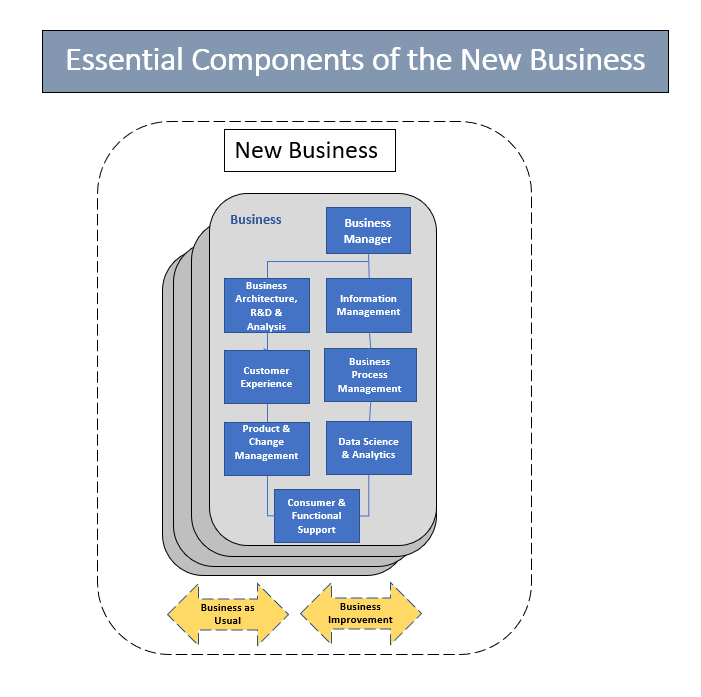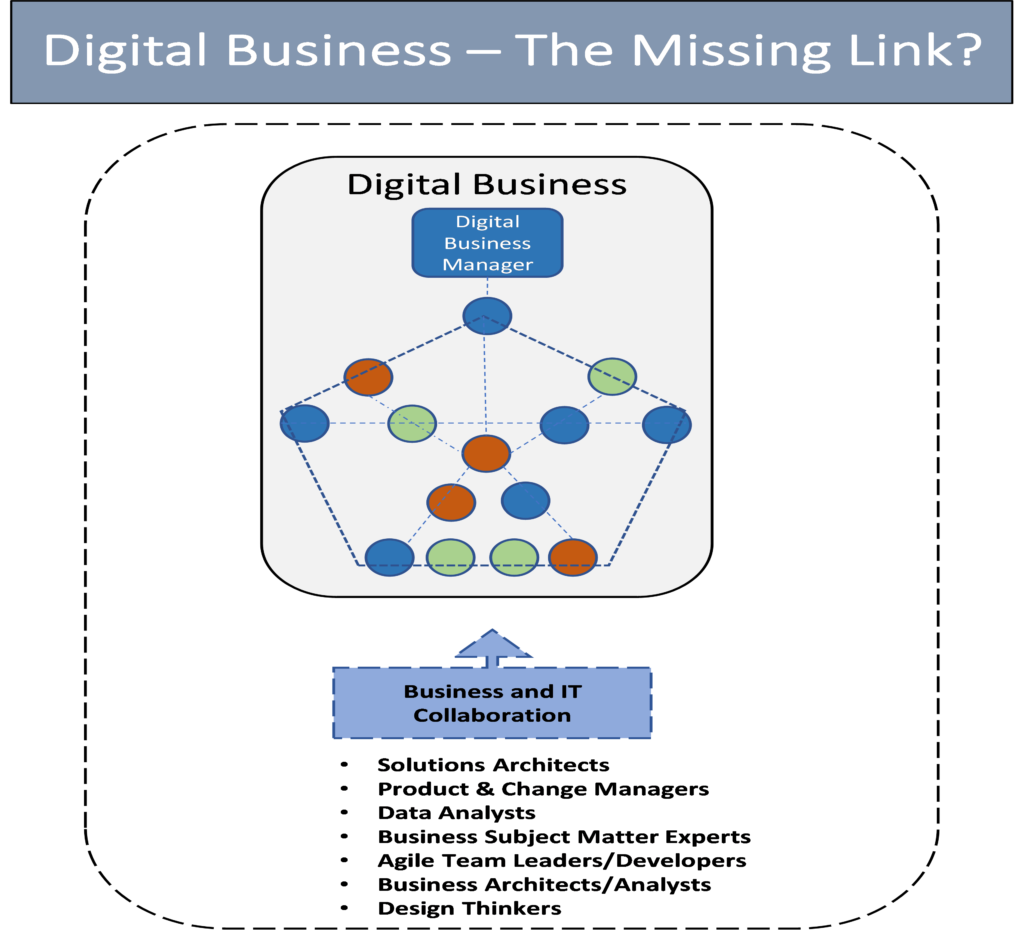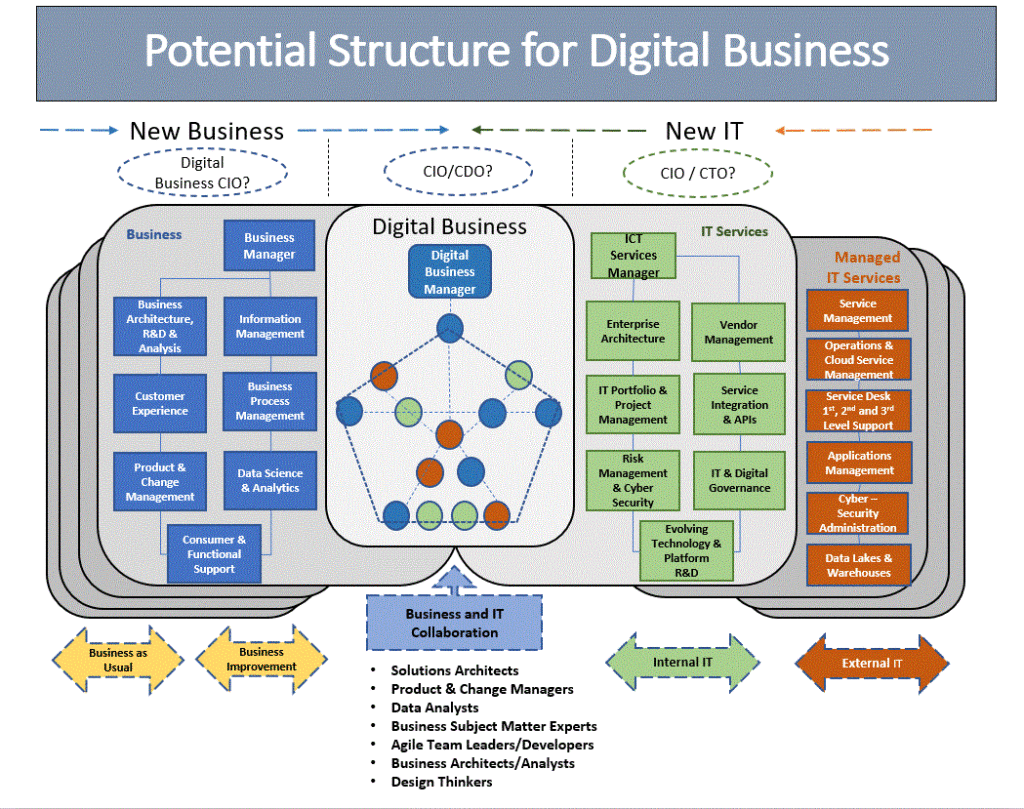Is it Time to Transform IT Organisations?
There have been a lot of conversations around the subject of alignment (or more misalignment) between IT and ‘the business’. This article presents ideas with a view to taking IT and business to the next level involving re-purposing, realigning and redistribution of some key capabilities.

- What went wrong with the insourced IT model?
It seemed to work for many years, but now the traditional IT in-sourced model falls short of business expectations. Let’s reflect on some of the failings:
| Failings | Causes | Remedies |
|---|---|---|
| Too much focus on keeping the lights on to the detriment of change initiatives | Scarce internal resources diverted from business change initiatives to put fires out | • More outsourcing of business-as-usual IT |
| Insufficient internal capabilities to support new technology and digital opportunities | Legacy systems necessitate retaining legacy skills | • Divest legacy applications support • Retain and build functional capabilities |
| Growing deficit in business and IT Alignment | Poor integration between business and IT | • Bring business and IT together (collaboration and/or unification) |
| Not communicating in business language | Lack of exposure to the business and lack of communication skills | • Spend more time in the business |
| Lack of transparency fails to reveal true costs of IT | Failure to attribute IT costs to services | • Clearly articulate whole-of-life costs of IT |
Whilst elements of the in-sourced model have been successful, others haven’t. Similarly, organisations have met with patchy success in applying centralised, centre-led, federated and distributed implementations. Maybe now would be a good time to move on ? Particular aspects of the in-sourced model that need to change include:
- Reduce or eliminate (outsource) internal IT commodity services
- Strengthen value-added capabilities including vendor management and service integration to improve effectiveness of outsourced service performance management
- Relocate business-intimate service to the business
- Strengthen capabilities around enterprise architecture, portfolio management and cyber-security
- Replace or migrate legacy applications to the cloud and externalise maintenance and support
- Establish consultancy and advisory services around new and emerging technologies.
The value proposition should reflect ‘customer intimacy’ with the mantra ‘IT working for the business’ being adopted.
Organisations seeking to establish or maintain competitive advantage (e.g. banks) might opt for a hybrid model where capabilities including applications development might well be retained as in-house services. Likewise, Spatial and GIS skills might be retained by government agencies although there are abundant opportunities to amalgamate such ‘shared services’ to reduce duplication and costs.
- When and why does Outsourcing fail?
It’s quite simple. When the short-term financial objectives of the outsourced organisation are allowed to outweigh the long-term commercial objectives of the relationship. So often the outsourcer recites the latter whilst applying the former. The reason this is allowed to happen reflects the fact that the contract that binds both the customer and the supplier is fundamentally designed to achieve such outcomes.
A good insight into the cause of some of the hidden costs of outsourcing can be found in a recent article published by CIO Magazine: https://www.cio.com/article/3301137/the-hidden-cost-of-outsourcing.html?utm_campaign=subscribers-NaN&utm_medium=subscribers_push_notification&utm_source=subscriberS
These include:
- Unanticipated disruption from COVID-19
- ‘Special Project’ and ‘Consulting creep’ costs (the familiar add-ons and variations that fall outside the outsourcing contract scope)
- Knowledge loss – failure to retain key employees that are transferred out of the client organisation
- Compliance costs to adhere to increasingly demanding regulatory requirements
- Under-investment in tools i.e. automation, AI and Robotics and the drive to achieve ROI
These cost drivers frequently put pressure on service levels when margins are eroded, resulting in such responses as withdrawing key resources and deterioration of the relationship following futile attempts to pass on costs to the client. This can result in forfeiting contract extensions, with expensive switching costs being incurred that can also impair reputations.
Particular aspects of the outsourced model that need to change inlcude:
- The mantra needs to switch from ‘maintaining business as usual’ to ‘demonstrating continuous improvement’
- The outsourcer needs to take true accountability i.e. for improving continuous service operations over the whole life of the contract
- Success needs to be managed in terms of business outcomes including return on investment and realisation of business improvements etc.
- Jointly develop a technology roadmap to underpin the continuous improvement strategy and agree funding responsibilities upfront
- Establish Service Level Agreements with IT and Consumer Agreements for separate portions of the business
- Provide a capacity plan that reflects realistic projected growth in data, users and service volumes.
In today’s volatile markets and workplaces, ‘business as usual’ is a fallacy and might be better branded ‘business as unusual’. In addition to providing for scalability, services need to be agile and flexible. Hence, contracts must reflect this.
- Time to rethink the IT organisation?
Yes. The old model is tired, and it lacks the flexibility and adaptability that the modern organisation demands. Figure One below lays out a potential new model for IT. Note that there is a clear split between internal roles and responsibilities and external roles and responsibilities. Having said that, the interface must be seamless and invisible to the consumers and customers.

The left side represents IT’s role as IT strategy facilitator, policy setter and goalkeeper. IT and Digital Strategy will form part of business strategy development, with continuous cycle updates. The ‘New IT’s purpose includes:
- Aligning IT with the business
- Assuring secure and uninterrupted access to systems and data
- Managing the IT portfolio including applications, programs and infrastructure
- Facilitating smooth execution of vendor services and operations
- Facilitating appropriate governance of IT investments
- Conducting research on platforms and emerging technologies such as VR/AR, Block-chain and Digital Twins etc., and providing consulting support for business areas.
Best practices, for example TOGAF and PRINCE 2 will be enforced. IT projects will oversee essential infrastructure and applications refresh/upgrade activities, with supplementary project managers and specialist resources being sourced externally, as needed.
The right side of Figure One reflects the roles and responsibilities of external service providers. These include IT service management and on-premise and cloud operations, monitoring and reporting performance against SLAs and contracts. Best practices around ITIL and DevOps/DevSecOps will apply, as well as continuous service improvements (e.g. AI, and Machine Learning) This will also encompass administration of cyber-security services and DRP facilities’ management.
The service desk will track problems through to resolution and coordinate asset registers to reflect changes, additions and disposals. Work requests (over agreed budget) will be assigned to the consumer support team (in the business) to be prioritised and actioned.
- How might the Business change?
Figure Two highlights changes that are overdue to the business. The focus is on activities that might traditionally be more akin to IT.

The intention is to firmly place responsibility in the business for:
- Business Architecture, R&D and design of new operating models
- Business Analysis
- Designing and orchestrating better customer’ experiences
- Product management
- Information management, analytics and data science
- Business Process Management
- Consumer and functional support.
These activities may be spread out over different parts of the business and will most likely be established as Centres of Excellence. Data needs to be owned by the business, including the responsibilities for standardisation, policy setting, cleaning, registration, privacy and governance. Unlike, functions and processes, data is static and therefore it provides a stable platform on which to architect the business.
- Delivering Digital Business
The final component in this new organisation is that of Digital Business. This is likely to comprise multiple teams representing the agile and adaptive element, designed to deliver new customer (or total) experiences and to redefine the way in which we do business. It is informed by data, digital by design and transient in nature, driving achievement of short, sharp targets. Figure Three illustrates how this may look.

Resourcing will be ‘just-in–time’ with a small core of dedicated players supplemented by secondments from the business and IT as well as external service providers and freelance contractors. Those providers will be pre-identified by early market testing based on the digital pipeline.
Product Managers will be assigned by the business to drive a portfolio of digital initiatives. Self-managed teams will form and reform to orchestrate iterative builds, testing and acquisition pilots. Achieving synchronicity with business process change (e.g. facilitating customer self-service) will be as important as ‘speed to market’ and potentially realising first-mover advantage.
Innovation will be encouraged, and lateral thinking rewarded whilst ‘lite’ governance will be practiced. Guidance and assurance will be applied by the business and IT with emphasis on achieving short and medium-term deadlines.
Of course, collaboration will be the key ingredient if this model is to work, both within Digital Business and across the elements of IT and Business.
- Putting it all together
Figure Four illustrates how the joined-up version of the new organisation might look.

The model also reflects three potential roles for the CIO. The first reflects the more traditional role as CIO/CTO overseeing the technical service end of the spectrum. The second depicts the role as CIO/CDO extending across Digital Business. And the third reflects the role of Digital Business CIO, extending his/her authority across ICT Services, Digital Business, and being embedded in the Business. The latter would be responsible for setting and achieving specific digital-business outcomes across the organisation.
- Summation
There is a lot of information to take on board. Nevertheless, this might serve to visualise thinking around a better way to approach IT and digital, and ultimately business in the future either as a whole or in part.
Above all else, the model seeks to challenge old models that are failing to deliver the right results for business. Some of the key take-outs should be:
- Business Architecture should reside in the business domain and be cultivated as a core business competency.
- Data and Information management should be nurtured as key resources in the business. Just as businesses need to regard data as an asset, they need to value it and treat it like any other asset.
- Collaboration between the business and IT (internal and external) will be essential if organisations are to realise a true return on their IT assets and data.
- Vendors and suppliers will need to lift their game to assure the reliability, value and sustainability of commodity IT services in order to earn the right to participate in the main (strategic) game.
- The focus of managed IT Services must shift away from achieving service levels to demonstrating continuous improvement.
- There is potential to expand the focus and role of the Digital Business CIO as a catalyst for transformation across organisation.
In conclusion, I suggest that, yes, it is time to transform IT organisations, in preparation for them to maximise their contribution to transforming the businesses that they serve.
I invite others to comment, based on their observations and offer views on the subject matter. Thank you.
